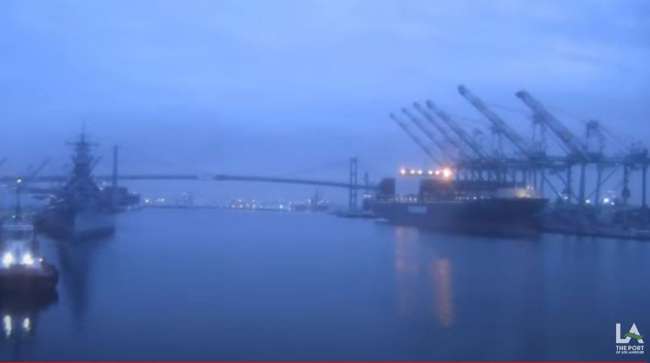Senior Reporter
February Container Volume High at Most Ports

[Stay on top of transportation news: Get TTNews in your inbox.]
Congestion at the nation’s ports will likely continue well into the year as February container numbers show a heavy volume of imports at the Pacific and Atlantic facilities.
In February, the nation’s busiest facility, the Port of Los Angeles, saw a nearly 47% year-over-year jump in the number of 20-foot-equivalent units that workers processed, moving 799,315 TEUs compared with 544,037 and businesses in China shut down as the COVID-19 pandemic raced through that country and temporarily closed its huge economy.
“One year ago, global trade slowed to a crawl as the COVID-19 pandemic first hit China and then spread worldwide,” Port of Los Angeles Executive Director Gene Seroka said. “Today, we are in the seventh month of an unparalleled import surge, driven by unprecedented demands by American consumers. Our challenges now are focused on getting port workers vaccinated and assisting stakeholders in managing this heavy flow of cargo.”
ICYMI: The Port of Los Angeles had a record February, processing 799,315 TEUs, up 47% compared to February 2020. It was the seventh consecutive month of year-over-year increases and the strongest February in the Port’s 114-year history. https://t.co/ccBo51aLf4 pic.twitter.com/drS3etrDWi — Port of Los Angeles (@PortofLA) March 23, 2021
The adjacent Port of Long Beach processed nearly as many containers, 771,735, a 43% increase over 538,428 in February 2020.
A Port of Los Angeles official told Transport Topics on March 23 that 25 containerships were waiting to unload at the two ports. Still, that number is down from January and February, when more than 30 ships a day were anchored off the Southern California coast, and if no additional ships entered the bay, it would take at least two weeks to clear the backlog.
Farther north, the Port of Oakland reported a 5.7% year-over-year increase in February, processing 190,553 containers, compared with 180,225. Officials said the port moved 80,200 containers that carried imported products, making it the busiest February for imported cargo in the facility’s 94-year history.
“Oakland continues to benefit from an unrelenting trade boom,” Maritime Director Bryan Brandes said, noting that officials also completed the assembly of three 174-foot, ship-to-shore cranes that are scheduled to go into operation in a matter of weeks, which officials say will improve the port’s efficiency.
Did you miss this one? Dramatic timelapse video of the assembly of a giant crane at Oakland. #timelapse #giantcranes2021 #stscranes #oakland #tallestcraneshttps://t.co/htElAd0kVX — Port of Oakland (@PortofOakland) March 22, 2021
The situation at the nation’s ports could be complicated in the coming days by a development in Egypt’s heavily traveled Suez Canal. On March 23, the Ever Given, a 1,312-foot, Panama-registered containership, ran aground and is blocking the waterway. Around 10% of the world’s total trade flows through the canal each year. It’s not clear how long it will take workers to free the vessel as its bow is stuck against the canal’s eastern wall, and the stern is lodged against the western wall. The giant ship had traveled through Taipei and Malaysia and was scheduled to arrive in the Dutch port city of Rotterdam in late March or early April.
The Northwest Seaport Alliance, which operates ports in Seattle; Tacoma, Wash.; Alaska; and Hawaii, reported processing a 0.9% year-over-year increase, moving 263,330 TEUs compared with 260,932. The rise was fueled by a 10.2% jump in international imports.
Last month we moved nearly 249,000 TEUs of our customers' cargo, an increase of 19% from February 2020. https://t.co/cJJp8Q3OAE#maritime #cargo #containers #supplychain #transportation #rail #vessel #shipping #logistics #transport #virginia #trucking pic.twitter.com/UKNvWwBsbb — The Port of Virginia (@PortofVirginia) March 18, 2021
On the East Coast, the Port of Virginia notched a 19.6% year-over-year increase processing 248,526 containers in February compared with 207,816.
“As the vaccination campaign gains momentum, the supply chains are opening up, and the economy — manufacturing and retail — is building strength, so we expect cargo flows to remain strong into the summer,” Virginia Port Authority CEO Stephen Edwards said.

Even before the pandemic, DHL's Larry S. Onge and Jim Monkmeyer set up strategies and implemented technology in order to respond to disruptions. Now, they know exactly how to get the vaccine from point A to point B — and, better, how to do it at a global scale. Hear a snippet, above, and get the full program by going to RoadSigns.TTNews.com.
South Carolina Port Authority, which operates Port of Charleston, reported a 7.6% TEU decline in February. Workers processed 182,269 TEUs compared with 197,214 a year earlier.
Officials blamed the drop on congestion delays at other ports, which caused fewer ships to arrive in Charleston and lower-than-expected volume.
However, roll-on, roll-off cargo, including cars, trucks, and agriculture equipment, exceeded expectations. For fiscal 2021, South Carolina ports have moved 165,528 vehicles, up 11% from last year.
South Carolina is home to several auto plants, including BMW, Volvo and Mercedes-Benz.
Port Houston also reported a substantial drop in container volume, falling 22% year-over-year to 198,763 from 255,474. It’s not clear if a new law in Texas restricting the size of containerships in the Houston Shipping Channel was responsible for the drop. The law, supported by the petroleum and chemical industries concerned about access to the channel, has caught the attention of Federal Maritime Commission officials. They have expressed concerns that the law may infringe on the agency’s authority to oversee interstate commerce.
Want more news? Listen to today's daily briefing below or go here for more info:

